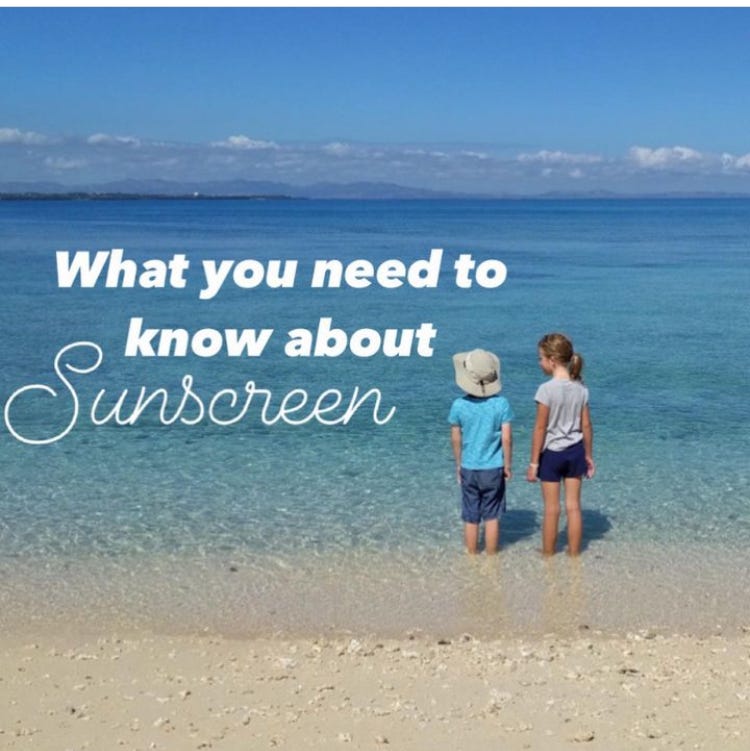
A couple years ago my sister got a terrible chemical burn from cheap sunscreen while at the beach. A fair maiden and her first day at the beach she thought she had been negligent to properly apply sunscreen.
As her discomfort grew into extreme pain she realized something else was going on. Turns out there was a class action lawsuit against the sunscreen maker. Millions of others had similar burn-like reactions.
She isn’t as crunchy as me and way more frugal. So the following year, I gave her clean sunscreen for her birthday…in February!
There are no federal regulations defining words like ‘natural, green or clean’ when it pertains to body care products, including sunscreens. Some brands add a very small percentage of an ingredient in their products, then advertise it as safe or organic.
In fact, companies are not required to disclose all the ingredients in products to protect the company’s “proprietary information,” which means they can hide ingredients under terms like “fragrance.”

The Sun is Our Friend
One of the best things we can do for our mental and physical health is to be outdoors. We want Vitamin D but don’t want to burn. As a woman who’s been around the sun a few times, I want to keep fine lines at a minimum! My family doesn’t always wear sunscreen all summer long. We wear it most at the beginning of summer and there are times when we are exposed to the sun longer than advantageous.
Of the 1,400+ sunscreens tested by the Environmental Working Group (EWG is a third party testing agency), only 5% met their safety standards. Almost half were listed as potentially contributing to skin cancer.
Terms for Sunscreen
UVA Rays = the sun’s skin Aging rays, 80% pass through clouds, UVA radiation penetrates skin tissue, cause cellular change over time that lead to cancer. Safe filters include clothing and zinc oxide.
UVB Rays = the sun’s Burning rays, stimulate Vitamin D production, cause cellular change over time that lead to cancer, can be blocked by sunscreen.
SPF = Sun Protection Factor
SPF 15 blocks 94% of rays
SPF 30 blocks 97% of rays
SPF 50 blocks 98% of rays (Source)
INGREDIENTS TO AVOID
Oxybenzone - hormone disruptor
Oxybenzone aka Benzophenone-3 is a super common ingredient in FDA approved sunscreens (why “FDA approved” means little to me). This ingredient is very effective at reducing UV exposure; simultaneously it is classified as a hazardous irritant for eye contact and slightly hazardous for direct skin contact.
Found in blood, urine & breastmilk samples from American population, meaning it penetrates the skin and infiltrates our circulatory system.
Scores 8/10 on EWG (10 being the most toxic)
Hormone disruptor that acts like estrogen in our body (i.e. a xenoestrogen)
Associated with endometriosis in women and altered birth weight in infants
Alters sperm production in animals
High likelihood to cause skin allergy
FDA study found blood levels 438 times above cutoff for systemic exposure
Found in the urine of 97% of Americans when sampled by the CDC (!!!)
Listed as a direct cause of coral bleaching and killing of coral reefs. As a result, Hawaii has banned the sale of sunscreens containing oxybenzone and octinoxate, starting in 2021.
Avobenzone
Avobenzone is another common ingredient in FDA approved chemical-based sunscreens. Often used to replace Oxybenzone in ‘Hawaii Compliant’ (reef-safe) sunscreens. This ingredient penetrates the skin, is a severe eye irritant and allergen. Highly unstable in the presence of UV light, it photodegrades with exposure to sunlight, increasing free radicals in the skin. [Free radicals are unstable molecules that are already naturally produced in the body may increase the risk of cancer and other diseases - so I don’t want more.]
Octinoxate - hormone and endocrine disruptor
Octinoxate, also known as octyl methoxycinnamate, is an organic compound that filters UVB rays from the sun. Studies have not shown octinoxate to be quite as toxic as oxybenzone, yet definite reasons to be wary of this ingredient in products.
It's found not only in sunscreens, but also lip balms, moisturizers, perfumes, hair sprays, aftershaves, hair color products, and nail polish.
Found in breastmilk samples from American population, meaning it penetrates the skin and enters the bloodstream
Hormone-like activity in the body
In animal studies, it alters thyroid, reproductive & behavioral systems
Moderate likelihood to cause skin allergy
FDA study found blood levels 13 times above cutoff for systemic exposure
Fragrance
Most main stream aerosol sunscreens are so smelly I frequently hold my breath when users invade my breathing space. Super toxic. When researching toxins in sunscreen, rarely fragrance is mentioned in the list of harmful ingredients. Yet fragrance is one of the top four offenders that I look to avoid.
The word fragrance is actually a loophole where anything can be added. It is NOT a single ingredient. This word could contain any combination of 3,000-plus stock chemical ingredients, including hormone disruptors and allergens.
Fragrance formulas are protected under federal law’s classification of trade secrets (proprietary information) therefore can remain undisclosed.
It’s such a difficult word to remove from daily consumption! Fragrance is in everything.
Retinyl Palmitate
A carcinogenic form of vitamin A that speeds the development of skin cancer when skin is exposed to sunlight.
Vitamin A toxicity can occur if applied in large amounts and repetitively over time.
Can form free radicals that contribute to aging. [Free radicals are unstable molecules that are already naturally produced in the body may increase the risk of cancer and other diseases - so I don’t want more.]
Look For These Words
Mineral based sunscreens physically deflects & blocks harmful UV rays and doesn’t harm the environment like chemically based sunscreens.
Zinc oxide is a naturally occurring mineral that has been used for centuries for medicinal and skincare properties. It acts as a physical barrier that reflects rays away from your body, and it prevents the body from absorbing harsh chemicals and rays from the sun. Look for non-nano zinc; we do not want nano technology absorbing into the bloodstream.
The Problem with Most Mineral Sunscreens
Let’s agree: not many people actually enjoy applying any type of sunscreen.
Mineral based sunscreens have an added layer of dread. The problem comes in the difficulty of application. Add to the experience a goopy sensation (or squirmy toddler!) and we have frustrations galore.
I loved every single Beautycounter sunscreen product. It was the only sunscreen we took to Fiji. Alas, the company is on pause. What am I trying now?
Daily I’ve been using this for my face from Arbonne. The body sunscreen rubs in great too.
A few other brand recommendations:
Crunchi - feels smooth, lightweight, and rubs in clear (a must!). Something else I appreciate is their packaging and safety testing. These are packaged in an infinitely recyclable aluminum bottle with a 100% BPA/BPS-free, and phthalate-free liner. Use code ADVOCATE10 to save 10% on your first order. I will be using Crunchi for makeup, too.
Pipette Baby - much thicker and takes more rubbing in, but clean ingredients and affordable
Attitude - a solid choice, available in most stores
Native
Think Baby - they recently adjusted their formula, but I think it’s still a better option if needing to grab something quickly at Target. It lathers in easier than other affordable options.
Badger & Earth Mama are safe options, but I find them to be difficult to rub in and leave a “white-cast.”
I’m not afraid of the sun. Most of the time we simply wear hats, rash guards or stay out of the sun during peak hours. However, sometimes sunscreen is imperative. When you need it - be sure to look for these words the next time you vote with your dollars.
Perfection isn’t the goal. Cleaner is. One swap at a time.
Julie
PS - To former Beautycounter customers:
DEAL ALERT: Arbonne is offering free Preferred Client status for the month of May. This is a rewards program similar to Band of Beauty but maybe better.
This gives 20% off every purchase and free shipping on purchases over $120 ($150 retail) for a year. AND when you hit the free shipping threshold, choose a FREE full-sized product with each order from a list of 10+ products (values up to $55!) this helps try more of their extensive product line. At checkout, it will prompt you at top of page to add Preferred Client to cart.
Otherwise get 10% off by using ARBONNE10.
Try Arbonne risk free — return products up to 90 days.
**Click here for Arbonne products and Beautycounter swaps I’m recommending.




